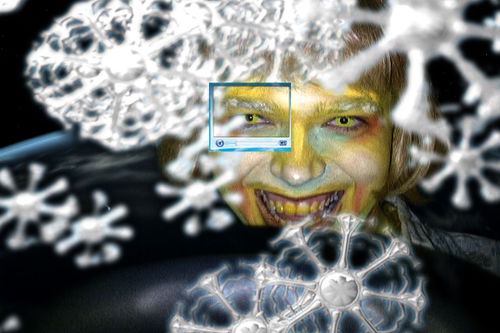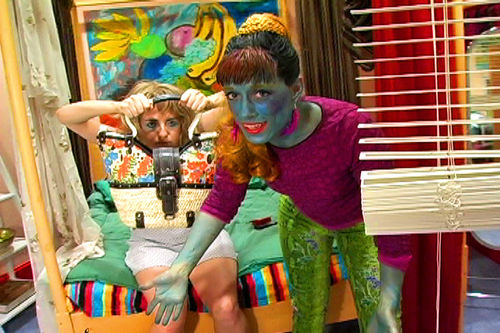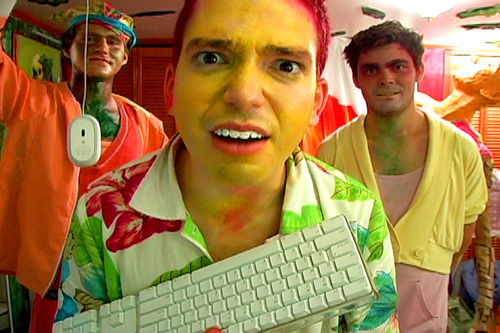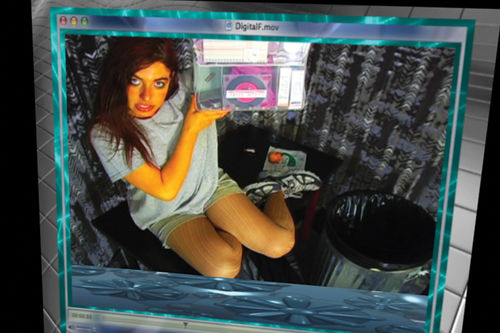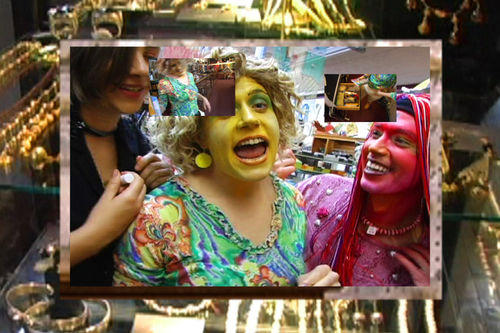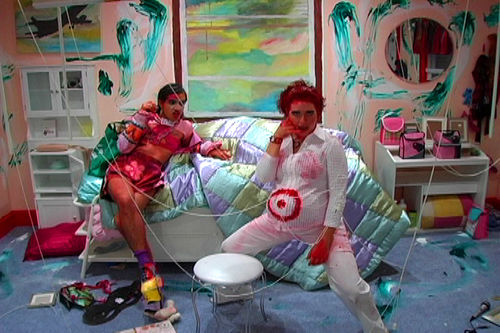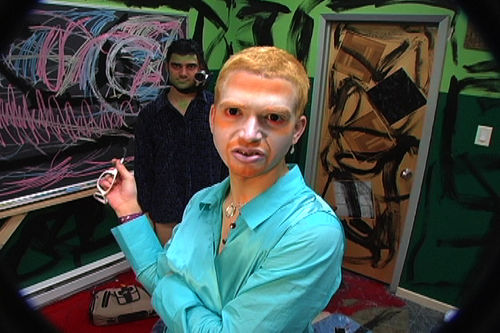
Hammer Projects: Ryan Trecartin
- – This is a past exhibition
Ryan Trecartin’s videos uncannily reflect his generation, which was raised using the Internet, digital television, and interactive video games. He mixes cheap special effects with absurd narratives in which he and his cast of collaborator-friends act out a sort of Lord of the Flies for the 21st Century. He tells sad love stories and bizarre family dramas utilizing technology to heighten the action and reflect the information overload we all experience today. In his latest work I-BE AREA (2007), Trecartin weaves together several unruly stories with fast-moving, fast-talking characters that deal with such themes as cloning, adoption, self-mediation, life-style options, virtual identities and larger questions of an existential nature. I-BE AREA (108 min) will be shown on the hour every other hour in the Hammer’s Video Gallery.
Organized by Hammer curator Ali Subotnick.
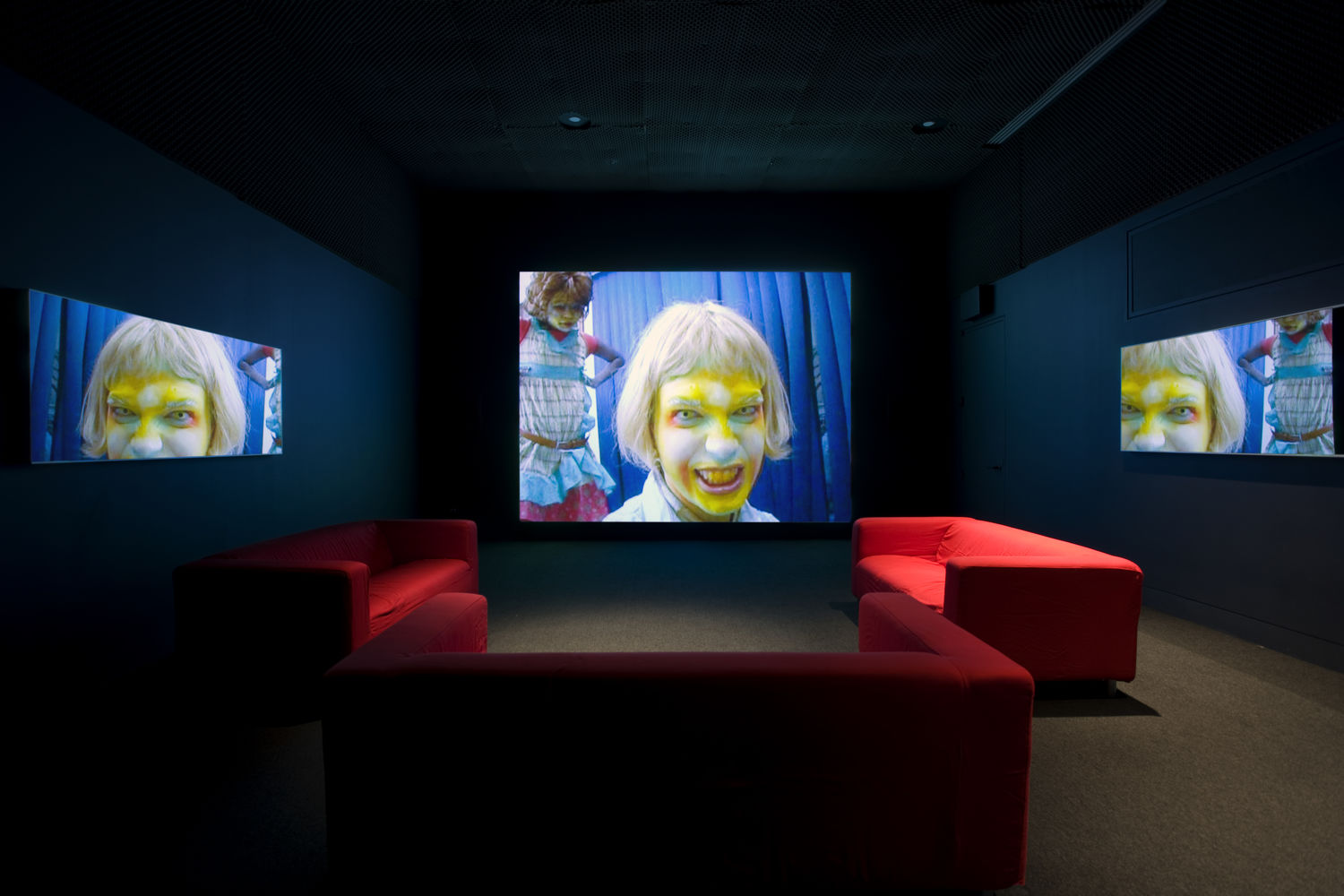
Biography
Ryan Trecartin was born in Webster, Texas, in 1981 and lives and works in Philadelphia. He received his BFA from the Rhode Island School of Design in Providence in 2004. He has had solo exhibitions at Elizabeth Dee Gallery, New York; QED, Los Angeles; and Crane Arts (Big Room Now), Philadelphia (in collaboration with Lizzie Fitch). Trecartin also participated in the 2007 Milan Triennale, the 2006 Whitney Biennial, and “USA Today” at the Saatchi Collection in London, also in 2006. His videos have screened at Anthology Film Archives, New York; the New Museum of Contemporary Art, New York; the Walker Art Center, Minneapolis; the Getty Center, Los Angeles; the Madison Museum of Contemporary Art, Madison, Wisconsin; and the Chicago Underground Film Festival (special jury prize). He is working on a new production that will be shown at the Moore Space in Miami in December 2008. This is Trecartin’s first solo museum exhibition.
Essay
By Kevin McGarry
The aide said that guys like me were “in what we call the reality-based community,” which he defined as people who “believe that solutions emerge from your judicious study of discernible reality.” I nodded and murmured something about enlightenment principles and empiricism. He cut me off. “That's not the way the world really works anymore,” he continued. “We're an empire now, and when we act, we create our own reality. And while you're studying that reality—judiciously, as you will—we'll act again, creating other new realities, which you can study too, and that's how things will sort out. We're history's actors . . . and you, all of you, will be left to just study what we do.”
—A senior adviser to George W. Bush, quoted in Ron Suskind, “Faith, Certainty and the Presidency of George W. Bush,” New York Times Magazine, October 17, 2004
The logic that twirls the fiendishly tortuous narrative of Ryan Trecartin’s second feature-length video, I-BE AREA (2007), is grounded in a powerful understanding of our new millennial world as composed of manifold realities that are created, copied, or canceled at the will of life’s advanced players. The guiding drama of the video is how the ensemble cast of shifting, splintered identities exploits, submits to, or breaks free of the existential frictions caused by inhabiting multiple realities at once—through different public personas, online avatars, the ongoing lives of cloned versions of yourself (or, if you happen to be a clone, any new identities you download for yourself), the erasures of previous identities that have been overwritten, or the old standby of children serving as vessels for anything you've ever wanted to be but aren't. An “Area” functions as a coalescence of a character’s accumulated realities, the turf to which the character is symbiotically and metaphysically bonded. The course of the film is a complete unraveling of I-Be’s Area, which is to say of itself.
The I-Be we follow is actually I-Be II, cloned from I-Be the original and played by Trecartin. As a clone, I-Be II is a blank slate. He is able to assume fully formed identities discarded by others but not to cultivate one inherently his own. Shunned by his clone-intolerant family group, I-Be II begins his odyssey by abandoning “I-Be” for a New Ohio girl named Oliver and renaming him/herself “Amerisha.” Each time he sheds a worn self for a new one, I-Be II lurches toward identity autonomy by asserting his own history through revisions to those handed down to him. Molding time and its living artifacts is a poetic as well as structural theme of I-BE AREA, and the key to tracing the trajectory of the characters and plot, which, otherwise lost, still soar above linear comprehension.
Pasta, another humanoid played by Trecartin, is a bright yellow, genderless mixed-media consultant who craves a baby at all costs. She steals one, and it is revealed that Pasta too was stolen as a child, before she had changed her name from Jango. Before is misleading, because her scenes and Jango’s take place simultaneously. Pasta has developed herself, Jango, into another person in order to seize maximal control of her options. Jango the child continues to live in temporal coexistence with Pasta the adult, perhaps unaware of Pasta yet destined to one day invent her.
Another character, Iyah, when asked why she would want to delete her birth mother, explains, “I want to feel endless in both directions. . . . It's personal.”
Shrieks of bliss score the unfurling of Pasta’s mothering romance with the stolen baby. Distorted skyward to dog pitches, they are anguished assertions of happiness, but their emptiness echoes through her condo. The entire video is a frightening but jubilant vision of aspirational consumerism run amok, a world whose want creation machine forces individuals to be merciless and creative in consuming elements for their original, nonlinear, exquisite personalities—to be postindustrialized by birth and detached from natural patterns of development in pursuit of instant life mastery. How they form character, morals, and family is aggressively capitalistic, focused on personal brand dissemination beyond the ordinary limits of physics. They multitask across simultaneous realities in order to optimize efficiency and efficacy in every extensible moment of being.
The “Area” whose anatomy is explored in the most depth is Jamie’s Area, which emanates from a pregnant, tyrannical drama teacher. Its exterior is a corporate building that I-Be II encounters after fleeing New Ohio, at a moment when he has ditched some of his Amerisha identity and is between selves. Eyeing Jamie's Area triggers a totemic impulse to buy the building, to assimilate it. Inside it is divided into three sections: the classroom, where Jamie presides over games of manipulation and humiliation; the bedroom, where relations are more balanced and sharing among individuals is possible; and the band practice space, where Jamie darkens to initiate performances of destructive expression.
Jamie's Area is a kind of Dostoyevskian wasteland magnetized to draw in those who, like I-Be II, are in a process of breaking down. Wandering its halls, I-Be II sees a mirror that reads “Sally was here” and, in an act that transgresses clone-identity sync, dives through to don the mantle of “SallyManNow,” an interpretation of who Sally might be now, as him: a largely self-authored identity that breaks beyond a clone's dependency on stories inherited from others. At this moment Jamie freezes I-Be II/SallyManNow in a pause, posed in a kiss with her muse. The still image evacuates I-Be II's personal narrative—who he has been and who he is yet to become—reducing it to a static representation that cannot speak for itself and is vulnerable to interpretation.
The pause, temporary, precedes the annihilation of Jamie's Area, which unfolds as a transmutation of her life force, a phoenix's death before rebirth. As she and her band sledgehammer the rooms, she tears off her prosthetic baby bump, screaming, “I did it for power!”—and by subverting her own Earth Mother identity, she liberates herself from reality defined by matter and body, tapping into the potential to create oneself by action and intention alone.
While lots of art stares into the past to reflect the present, I-BE AREA meditates on a unique and concrete idea of the near future. It is social science fiction set in a time capsule of modern anxieties and technologies, sealed, tumbled, and amplified into a hyperbolic new world. Trecartin's wizardry of self-cannibalizing video tracks, careening editing, and yuppie-dementia-born art direction cumulatively offers a perspective on today that feels truly distant from now. The video is interspersed with jarring reminders of normal humanity—performances by real babies, real cats, and real Ohio moms—adding a texture of analog realness that counterbalances the chroma-charged dream.
I-BE AREA’s final shot is a panorama of Jamie's wrecked bedroom, under which the actors, out of character, can be heard giggling before one of the smashed windows lights up with digital water and we’re plunged into an aquatic credit sequence. As if the whole movie were sucked up into a genie's lamp, we see the space for what it is, without manipulations, three dimensions only.
What I-BE AREA unravels into is an Ouroboros of total freedom, in which command of infinite options devours linearity and, with it, any fixity of location or person. Everything is subject to revision. Supreme choice begins to resemble the absolute lack thereof, as both conditions are a step removed from the pulse of the surrounding world. But the power of freedom isn't derived from its essence; it is told in the story of how it was won.
Kevin McGarry is a writer and film/video programmer living in Brooklyn and Philadelphia. He was a codirector of the New York Underground Film Festival and now codirects the organization that grew out of it, Migrating Forms, which will present its first festival in spring 2009.
Hammer Projects is made possible with major gifts from Susan Bay-Nimoy and Leonard Nimoy and The Horace W. Goldsmith Foundation.
Additional generous support is provided by the Los Angeles County Arts Commission, Good Works Foundation and Laura Donnelley, the David Teiger Curatorial Travel Fund, and Fox Entertainment Group’s Arts Development Fee. Gallery brochures are underwritten in part by the Pasadena Art Alliance.



